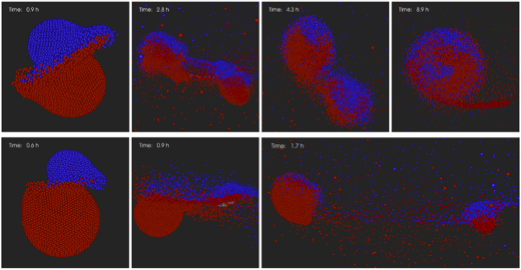A Comprehensive and Self-consistent Approach to the Late Accretion and Composition of Rocky Planets
- 1Planetary Science Institute, Honolulu, United States of America (nader@ifa.hawaii.edu)
- 2University of Tübingen, Tübingen, Germany
We have developed a comprehensive and self-consistent approach to simulate the late accretion and composition of terrestrial/rocky planes. Our approach begins with simulating the collisional growth of planetesimals and continues with resolving giant impacts using our state-of-the-art SPH-based model. We take into account all relevant physical processes including the dynamical friction due to the debris and planetesimal disks, migration of planetesimals and embryos, and the perturbation as well as possible migration of giant planets. As the most important step toward a fully comprehensive and realistic model, our approach incorporates SPH simulations into N-body integrations in real time allowing collisions to be simulated accurately as they occur. Results point to several important findings. For instance, in the context of our solar system, almost all simulations produced an Earth-analog. In the context of extrasolar planets, when giant planet migration was considered, rocky super-Earths were produced routinely. Simulations also show that the capture into resonance of migrating giant planets does not play a significant role on the formation of rocky planets. The most important finding of our simulations is that while giant planets may affect the inventory of planet-forming material, hence their compositions, they play no role in the mechanics of the formation of rocky planets and the transfer/transport of chemical compounds to them. Formation and delivery of chemical compounds are merely due to the mutual interactions of planetary embryos, a process that occurs even when no giant planet exists. We will present the results of our study and discuss their applications to the formation, composition, and early differentiation of Earth-like planets and rocky super-Earths.

Figure 1: Snapshots of SPH simulations of two different collisions. The impactor (smaller body, in blue) approaches the target from the left. The color coding represents different compositions, e.g., water on the impactor in blue and silicate material (basalt) in red. Iron core material (light gray). Top: Accretionary collision, graze-and-merge, where after a brief hit-and-run-like period the bodies fall back and merge. Bottom: Typical hit-and-run encounter with only relatively little volatile transfer. (Burger et al., 2020, A&A, 634, A76)
How to cite: Haghighipour, N., Burger, C., and Schäfer, C.: A Comprehensive and Self-consistent Approach to the Late Accretion and Composition of Rocky Planets, Europlanet Science Congress 2024, Berlin, Germany, 8–13 Sep 2024, EPSC2024-855, https://doi.org/10.5194/epsc2024-855, 2024.